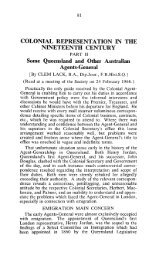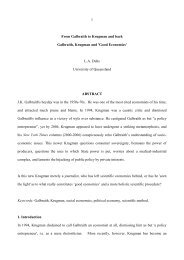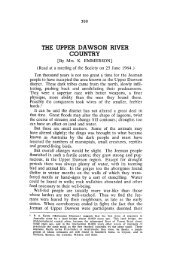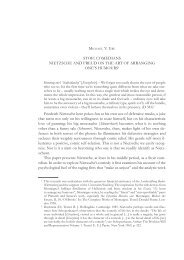Body language: - UQ eSpace - University of Queensland
Body language: - UQ eSpace - University of Queensland
Body language: - UQ eSpace - University of Queensland
Create successful ePaper yourself
Turn your PDF publications into a flip-book with our unique Google optimized e-Paper software.
Abstract<br />
Effective communication in the dental setting is imperative to the quality <strong>of</strong> health care delivery. Many<br />
patients present at the dental clinic with phobias, fears, anxiety and confusion. The first impression the<br />
clinician makes on the patient can dictate the outcome <strong>of</strong> treatment. Patients are more responsive to<br />
treatment suggestions and ideas if they feel comfortable with the health provider. Good communication<br />
skills can greatly assist the clinician in acquiring an accurate history <strong>of</strong> the presenting complaint,<br />
arriving at a diagnosis, and translating this information into an appropriate treatment plan that the<br />
patient can understand. This can increase patient compliance and satisfaction, and minimise future<br />
potential misunderstandings. This paper highlights techniques health care pr<strong>of</strong>essionals can use to<br />
improve their communication skills.<br />
Introduction<br />
The relationship between health care pr<strong>of</strong>essionals and their patients has been identified as one <strong>of</strong> the<br />
most important elements <strong>of</strong> the health care delivery process. 1-4 This relationship has been cited as a<br />
major factor in patient non-compliance, dissatisfaction with the health care system, and the increase in<br />
malpractice suits. 5-8 Considering the potential problems that can occur due to poor communication<br />
between health care pr<strong>of</strong>essionals and patients, it becomes apparent that good communication skills,<br />
and dealing with patients in a personalised and individualized manner, is essential if successful<br />
pr<strong>of</strong>essional-patient relationships are to be formed. 9-11 Communication can be broken down into three<br />
basic lessons; 1) everything we do is communication, 2) the way we begin our message <strong>of</strong>ten<br />
determines the outcome <strong>of</strong> the interaction, and 3) the way a message is delivered will affect the way the<br />
message is received. 12-14<br />
In this paper, strategies are outlined for effective communication in a health delivery setting (Table 1),<br />
and procedures that maximise the practitioner-patient interaction, and those that distract from it are<br />
highlighted (Table 2). The steps outlined aim to assist the health care provider in ensuring the quality<br />
delivery <strong>of</strong> health services by emphasizing good communication techniques.<br />
Image and first impressions<br />
Approximately 60% <strong>of</strong> first impressions health pr<strong>of</strong>essionals make on their patients are based on<br />
appearance (that is, presentation, dress, and other less controllable factors such as age, height, weight,<br />
and gender). 4,15 This first impression will affect a patient's behaviour and attitude in subsequent<br />
communication, 10,16,17 and so it is vital that clinicians and auxiliary staff create a friendly and<br />
approachable impression, as a significant effort is required to retrieve a patient's confidence once<br />
lost. 10,12,14,15,17 A sincere smile improves the first impression and the entire communication process. 13,17<br />
<strong>Body</strong> <strong>language</strong><br />
<strong>Body</strong> <strong>language</strong> is a vital ingredient in effective communication. 13,18 It is argued that because non-verbal<br />
communication was first used by humankind, people are programmed inherently to respond first and<br />
foremost to non-verbal signals. 19-21 In fact, research indicates that the way people deliver a message<br />
accounts for up to 93% <strong>of</strong> its meaning. 8,13,15 The more control people have over the non-verbal<br />
messages they send, the more control they have over the communication process itself. 13,22 The "right"<br />
body <strong>language</strong> displaying an open receptive approach can assist health providers in obtaining pertinent<br />
patient information that will assist in diagnosis and treatment. 8,13,15,23<br />
The way health pr<strong>of</strong>essionals sit, stand, and walk, conveys much about them to others. 13,23 Upright<br />
posture conveys a sense <strong>of</strong> calm, composure, confidence, and competence. 13,15 Many health care<br />
settings, including the dental <strong>of</strong>fice, evoke considerable fear and uncertainty in patients. 9 To lessen<br />
this, patients become especially alert to information in their environment and the body <strong>language</strong> <strong>of</strong> their<br />
health provider. 9,23 This is why it is extremely important to stay in control <strong>of</strong> non-verbal messages. 9,24<br />
2


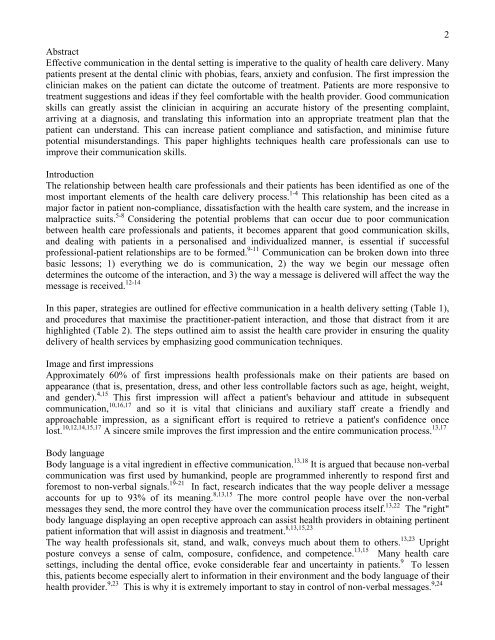


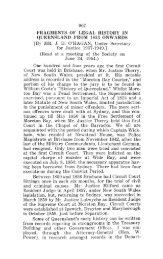


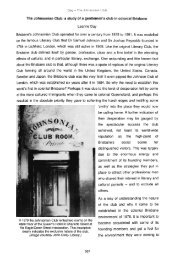

![Kanaka Labour in Queensland, [ises-mi] - UQ eSpace](https://img.yumpu.com/21925421/1/163x260/kanaka-labour-in-queensland-ises-mi-uq-espace.jpg?quality=85)
